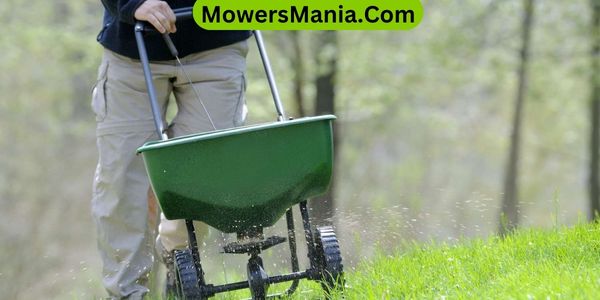If you want a lush, green lawn, knowing when to fertilize is key. In this article, you’ll learn the best times to feed your lawn for maximum growth and health.
Understanding your grass type is the first step, and then you’ll dive into the specific fertilization schedule for early spring, late spring, early summer, mid to late summer, and fall.

Get ready to transform your lawn into a vibrant oasis with the right fertilization strategy.
Understanding Your Grass Type
If you want a greener lawn, you need to understand your grass type. Different grasses have different needs, so identifying your grass type is crucial for proper lawn care.
Start by examining the grass in your lawn. Is it fine-bladed or coarse? Does it spread by stolons or rhizomes, or does it grow in bunches?
These characteristics can help you determine if you have a warm-season grass like Bermuda or Zoysia, or a cool-season grass like Kentucky bluegrass or fescue.
Understanding your grass type will dictate how you should mow, water, and fertilize your lawn. For example, warm-season grasses thrive in warmer climates and require different mowing heights and watering schedules compared to cool-season grasses.
Fertilizing at the wrong time or with the wrong type of fertilizer can harm your lawn. Once you know your grass type, you can tailor your lawn care practices to promote healthier, lusher grass.
Early Spring Fertilization
To ensure a greener lawn, begin by considering early spring fertilization as a key aspect of your lawn care routine.
Understanding your grass type is essential for determining the right time and type of fertilizer to use, and early spring is a critical period for providing the necessary nutrients for robust grass growth.
As the temperatures start to warm up and your grass begins to come out of dormancy, it’s the perfect time to give it the boost it needs to thrive throughout the growing season.
When choosing a fertilizer for early spring application, look for products with a high nitrogen content. Nitrogen is crucial for stimulating leaf and stem growth, giving your lawn that lush, green appearance.
Ideally, opt for a slow-release nitrogen fertilizer to provide a steady supply of nutrients over several weeks, promoting sustained and even growth.
It’s important to apply the fertilizer evenly and according to the manufacturer’s instructions, ensuring that you don’t over or underfeed your lawn. Additionally, be mindful of any local regulations or guidelines regarding fertilizer application to prevent any environmental impact.
With the right timing and proper application, early spring fertilization can set the stage for a vibrant and healthy lawn throughout the year.
Late Spring and Early Summer Boost

As you enter the late spring and early summer period, continue nurturing your lawn’s health and vibrancy by providing a second round of fertilizer for sustained growth and lush greenery.
During this time, your lawn is actively growing and using up nutrients, making it essential to support its needs. Look for a balanced fertilizer with a higher nitrogen content to encourage leaf and stem development.
Applying fertilizer during late spring provides the necessary nutrients for your lawn to recover from any stress it may have experienced and prepares it for the upcoming warmer months. Aim to apply the fertilizer in the early morning or late afternoon to prevent it from evaporating in the heat.
Water your lawn after applying the fertilizer to help it settle into the soil. Remember to follow the recommended application rates to avoid over-fertilizing, which can lead to issues such as thatch buildup.
With this timely boost, your lawn will thrive and maintain its vibrant green color throughout the summer.
Mid to Late Summer Application
Continuing from late spring and early summer, as your lawn enters mid to late summer, it will benefit from another round of fertilizer to maintain its health and lush appearance.
The mid to late summer application of fertilizer is crucial for providing essential nutrients and maintaining the overall health of your lawn.
Here’s what you need to consider for this stage:
- Choose the Right Fertilizer: Look for a fertilizer with a balanced blend of nitrogen, phosphorus, and potassium. This will support healthy growth and help the grass withstand the stresses of summer heat.
- Timing is Key: Apply the fertilizer during the cooler parts of the day to prevent the risk of burning the grass. Early morning or late afternoon is ideal for application.
- Watering After Application: After applying the fertilizer, ensure your lawn receives a deep watering. This helps the nutrients penetrate the soil and reach the grassroots, promoting healthy growth.
Fall Feeding for Winter Preparation

Prepare your lawn for the winter by scheduling a fall feeding to fortify its resilience and health during the colder months.
As the weather gets colder, your lawn’s growth slows down, making it the perfect time to provide it with the essential nutrients it needs to survive the winter. A fall feeding with the right fertilizer will help your lawn develop stronger and deeper roots, which are crucial for withstanding the harsh winter conditions.
Look for a fertilizer with a high potassium content, as this nutrient plays a key role in strengthening the grass plants and improving their ability to withstand cold temperatures and disease.
Additionally, a fall feeding will also help your lawn recover from any stresses it may have experienced during the summer months, such as heat, drought, or heavy foot traffic.
Frequently Asked Questions [FAQs]
Can I Use the Same Fertilizer for My Lawn as I Do for My Garden Plants?
Yes, you can use the same fertilizer for your lawn as you do for your garden plants. It’s convenient and can save you money. Just make sure it’s suitable for both and follow the recommended application guidelines.
Is It Safe for Pets to Be on the Lawn After Fertilizing?
After fertilizing, it’s best to keep pets off the lawn for a while to avoid potential ingestion or irritation. Once the fertilizer has been watered in and the lawn is dry, it should be safe for your pets to enjoy.
How Often Should I Aerate My Lawn When Fertilizing?
When fertilizing your lawn, aerate once a year for best results. This helps the fertilizer reach the grassroots and promotes a healthier, greener lawn. Aeration also improves air circulation and reduces soil compaction.
What Is the Best Type of Spreader to Use for Applying Fertilizer?
When applying fertilizer, use a broadcast spreader for even coverage. Adjust the spreader settings based on the fertilizer type and your lawn size. Walk at a steady pace and overlap wheel tracks for consistent results.
Are There Any Natural or Organic Alternatives to Traditional Lawn Fertilizers?
For a greener lawn, consider natural alternatives to traditional fertilizers like compost, fish emulsion, or seaweed. These options provide nutrients without harsh chemicals. They’re effective and environmentally friendly, promoting a healthy lawn.
Conclusion
Now that you know when to fertilize for a greener lawn, you can keep your grass looking lush and healthy all year long. By understanding your grass type and following the proper fertilization schedule, you can promote strong root growth, vibrant color, and overall resilience to environmental stressors.
With a little bit of effort and the right timing, you can enjoy a beautiful lawn that enhances the curb appeal of your home.



